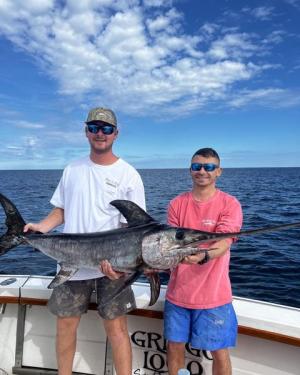Back on Sept. 19, I received an email from Rick Levinson who was concerned about all the peanut dolphin he sees spread out on the docks and cleaning tables. He believes these small dolphin should be released to grow larger, and in a year, they would be 20-pound gaffers. Rick currently owns the 64-foot Viking Seaflame and has been fishing out of Indian River since 1960.
He is absolutely correct. Dolphin (aka mahi-mahi) are one of the fastest-growing fish in the sea and, no doubt, if those peanuts lived for another year, they would be 20-pound gaffers. The problem is they probably won’t live that long.
Pretty much everything that’s bigger than a dolphin eats a dolphin. That includes bigger dolphin eating smaller dolphin.
As recreational regulations currently stand in Delaware, you are allowed 10 dolphin per angler, with no size limit. These are actually federal regulations and apply to the East Coast from Virginia to Maine.
Back in the 1980s, when I ran EBB Tide Guide Service from Virginia Beach, the charter captains from several ports got together and decided to put a 10-fish limit on dolphin. Back then, you had to run to deep water to find dolphin, and one trip had two men who wanted a white marlin. We did raise one white out at the Norfolk Canyon, but since they insisted on doing everything themselves and had no experience with billfish, the angler completely missed his chance.
Fortunately, we came upon a very large weed bank. There must have been about a million dolphin underneath and I set my guys up with spinning outfits and bucktails. This they handled very well.
Soon they had their 30-fish limit in the box. I asked if they minded if I caught three fish for my personal use. They said OK and I made a long cast to the 20-pounder I had seen on the edge of the weeds. He tore up the water, but I did manage to gaff him myself and put him in the box. Two more of the smaller fish and we headed for the dock.
I was able to do this because the regulations were self-imposed. Today, I would be breaking the law.
Now I read in Salt Water Sportsman that federal regulators are considering new limits on dolphin from North Carolina to Maine. Currently, Florida has a 20-inch size limit on dolphin, and this limit is now under consideration for all states along the East Coast. Florida harvests 65% of East Coast dolphin, with North Carolina taking 23%. Both states enjoy being very close to the warm waters of the Gulf Stream.
There is also talk of reducing the bag limit for recreational fishermen. That would be a major blow to the charter and head boat fishery.
In recent years, Delaware anglers have enjoyed excellent dolphin action in late summer as close as the Del-Jersey-Land Reef and even closer on some days. Few of the fish caught would measure 20 inches.
The article in Salt Water Sportsman quotes Chris Burrows, chairman of the Dolphin/Wahoo Advisory Panel for the South Atlantic Fishery Management Council, who points out that dolphin have a 99% mortality rate in their first year. He also notes that commercial fishermen have taken to setting long lines along every bed of floating grass in the Gulf Stream. These will be bringing in countless numbers of dolphin of all sizes, with most well under 20 inches.
I do hope cooler heads prevail. Just when we get a new inshore fishery, the powers that be may decide to ruin it. Dolphin are a prolific fish that don’t have a long life, grow very quickly and do not seem to be under stress from recreational fishing. They are often trip savers as they were for me back in Virginia, and at this point in time, I believe current regulations are sufficient.
Watch the weather
Actually, you may be better off not watching the weather on TV. The blow-dry weather guys and girls don’t seem to have a good grip on the marine forecast. Just the other night, one of them called for a small-craft advisory for 2-foot seas on Chesapeake Bay. That would have to be a really small craft to get in trouble in 2-foot seas.
Of course, the real danger is when they forecast 10 to 15 knots northwest on Delaware Bay and never mention what that does during incoming current. It stacks them up, that’s what it does, and this time of year that can be very dangerous. Always consider the current direction against or with the wind when figuring wave height. Knowing that result can save you from a very harrowing ride.

























































